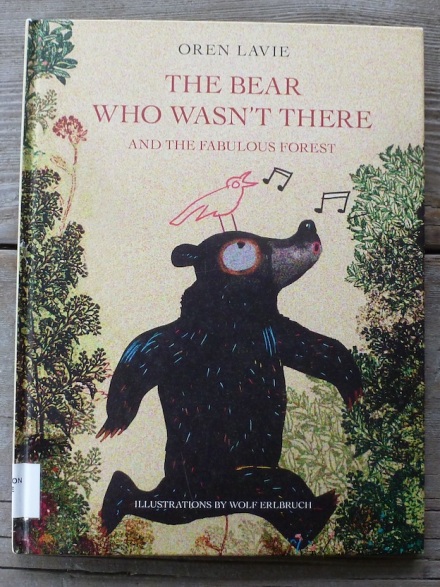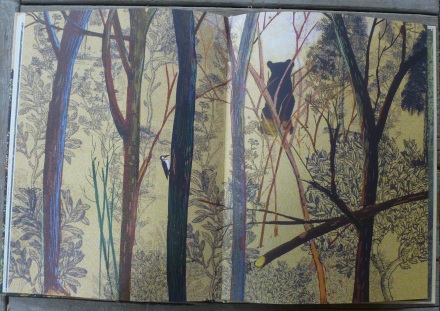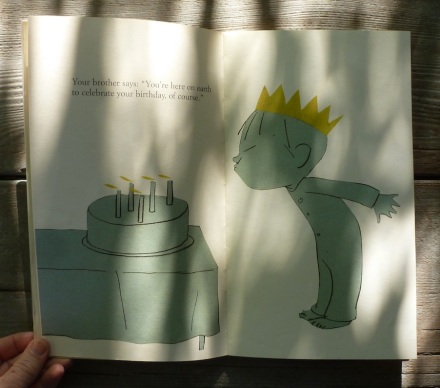To close the series this month on Wolf Erlbruch, I’d like to introduce three titles that he illustrated for other authors. To read the other posts, click HERE, HERE, or HERE. Enjoy! Edited by: Lee Bennet Hopkins
Edited by: Lee Bennet Hopkins
Illustrator: Wolf Erlbruch
Publisher: Harper Collins, 2005
Age: 4-8
Themes: conduct of life, children’s poetry, emotions
Opening: This isn’t the way it was supposed to be- You in Room Two. Me in Room Three.
 Summary: Poignant and funny American poems for children selected by Lee Bennett Hopkins.
Summary: Poignant and funny American poems for children selected by Lee Bennett Hopkins.
 Why I like this book: I love suggesting books of poetry for emerging readers, especially humorous ones. These all touch on the feelings we all share of what it is like to have a really bad day. I love the simplicity in rendering and arresting compositions that snuggle up perfectly to each poem.
Why I like this book: I love suggesting books of poetry for emerging readers, especially humorous ones. These all touch on the feelings we all share of what it is like to have a really bad day. I love the simplicity in rendering and arresting compositions that snuggle up perfectly to each poem.
Resources/Activities: write poems about a bad-day experience you may have had.
 Author: Gioconda Belli, translated from the Spanish by Charles Castaldi
Author: Gioconda Belli, translated from the Spanish by Charles Castaldi
Illustrator: Wolf Erlbruch
Publisher: Peter Hammer Verlag/Europa Editions, 1994/2005
Age: 7-11
Themes: imagination, inventors, insects
Opening: Butterflies are almost weightless. They are ever so light, like the batting of an eyelid, the sun blinking red and yellow.
 Summary: (from fantasticfiction.com) Odair, one of the “Designers of All Things” and grandson of the esteemed inventor of the rainbow, has been banished to the insect laboratory as punishment for his overactive imagination. But he still dreams of one day creating a cross between a bird and a flower. Then, after a helpful chat with a dog . . .
Summary: (from fantasticfiction.com) Odair, one of the “Designers of All Things” and grandson of the esteemed inventor of the rainbow, has been banished to the insect laboratory as punishment for his overactive imagination. But he still dreams of one day creating a cross between a bird and a flower. Then, after a helpful chat with a dog . . .
 Why I like this book: Every illustration is a gem! For illustrators this is a beautiful edition from which to study what the silhouette of a character can lend to visual storytelling. And I believe children and adults alike can relate to the inventive main character who is one of the ‘Designers of All Things’.
Why I like this book: Every illustration is a gem! For illustrators this is a beautiful edition from which to study what the silhouette of a character can lend to visual storytelling. And I believe children and adults alike can relate to the inventive main character who is one of the ‘Designers of All Things’.
Resources/Activities: consider the kinds of insects or flowers you might like to invent.
 Author: Oren Lavie
Author: Oren Lavie
Illustrator: Wolf Erlbruch
Publisher: Verlag Antje Kunstmann/Black Sheep, 2014/2016
Age: 6-8
Themes: itching, bears, identity
Opening: Once upon a time there was an Itch. Simply, an Itch.
 Summary: (from my library catalog) One day, a few minutes after Once Upon a Time, a bear awakes to find he has lost something very important: himself! He sets out into the Fabulous Forest to find himself, using only a few clues scrawled on a piece of paper: the bear he’s looking for is a nice bear; he is a happy bear; and he’s very handsome too! These sound like pretty good qualities to Bear, and so begins his memorable journey. With the help of Fabulous Forest critters like the Convenience Cow, theLazy Lizard, and the Penultimate Penguin, Bear finds that he himself is just what he’s been looking for all along: a nice, happy bear–and handsome too!
Summary: (from my library catalog) One day, a few minutes after Once Upon a Time, a bear awakes to find he has lost something very important: himself! He sets out into the Fabulous Forest to find himself, using only a few clues scrawled on a piece of paper: the bear he’s looking for is a nice bear; he is a happy bear; and he’s very handsome too! These sound like pretty good qualities to Bear, and so begins his memorable journey. With the help of Fabulous Forest critters like the Convenience Cow, theLazy Lizard, and the Penultimate Penguin, Bear finds that he himself is just what he’s been looking for all along: a nice, happy bear–and handsome too!
 Why I like this book: The text is full of gags, silliness and wordplay that are accompanied by equally playful and light illustrations making wonderful use of collage.
Why I like this book: The text is full of gags, silliness and wordplay that are accompanied by equally playful and light illustrations making wonderful use of collage.
Resources/Activities: make a list of character traits you believe belong to you.
For more Perfect Picture Book picks with teacher/parent resources, check out the list on Susanna Hill’s blog HERE.

 Author/Illustrator: Wolf Erlbruch, winner of the 2017 Astrid Lindgren Memorial Award
Author/Illustrator: Wolf Erlbruch, winner of the 2017 Astrid Lindgren Memorial Award Why I like this book: very simply, and beautifully, the book addresses why we our main character is here on earth, as perceived through multiple characters and examples. Many thanks to
Why I like this book: very simply, and beautifully, the book addresses why we our main character is here on earth, as perceived through multiple characters and examples. Many thanks to  Resources/Activities: come up with more characters and create examples, maybe a picturebook maker would say, “You’re here for me to tell you stories.” ; read the book in the first post in this series
Resources/Activities: come up with more characters and create examples, maybe a picturebook maker would say, “You’re here for me to tell you stories.” ; read the book in the first post in this series  For more Perfect Picture Book picks with teacher/parent resources, check out the list on Susanna Hill’s blog
For more Perfect Picture Book picks with teacher/parent resources, check out the list on Susanna Hill’s blog  I took the book pictures just before the one above of the big spring snow dump! Picture taken before the end of the storm – hope the shrubs will recover!
I took the book pictures just before the one above of the big spring snow dump! Picture taken before the end of the storm – hope the shrubs will recover! Author/Illustrator: Wolf Erlbruch, winner of the 2017 Astrid Lindgren Memorial Award
Author/Illustrator: Wolf Erlbruch, winner of the 2017 Astrid Lindgren Memorial Award Why I like this book: I bought this incredibly silly adaptation of the American nursery rhyme, of which there are a number of highly controversial adaptations (
Why I like this book: I bought this incredibly silly adaptation of the American nursery rhyme, of which there are a number of highly controversial adaptations ( Resources/Activities: read other adaptations, and should you come across controversial ones, and the kids are ripe for it, discuss the matter. Read the first post in this series on Wolf Erlbruch books
Resources/Activities: read other adaptations, and should you come across controversial ones, and the kids are ripe for it, discuss the matter. Read the first post in this series on Wolf Erlbruch books  For more Perfect Picture Book picks with teacher/parent resources, check out the list on Susanna Hill’s blog
For more Perfect Picture Book picks with teacher/parent resources, check out the list on Susanna Hill’s blog  This month my picks for Perfect Picture Book Friday will feature
This month my picks for Perfect Picture Book Friday will feature  Author/Illustrator: Wolf Erlbruch, ; translator: Catherine Chidgey
Author/Illustrator: Wolf Erlbruch, ; translator: Catherine Chidgey
 Why I like this book: I like this book in particular for the gentle way in which the author approaches the subject, with very little explaining, lots of quiet moments, just enough humor and the strong emotions conveyed in the posturing of the characters. It amazes me how sparse and how rich a book can be at once.
Why I like this book: I like this book in particular for the gentle way in which the author approaches the subject, with very little explaining, lots of quiet moments, just enough humor and the strong emotions conveyed in the posturing of the characters. It amazes me how sparse and how rich a book can be at once. Resources/Activities: read then discuss the book with your child(ren), but do not lead the conversation, just watch as it floats.
Resources/Activities: read then discuss the book with your child(ren), but do not lead the conversation, just watch as it floats. For more Perfect Picture Book picks with teacher/parent resources, check out the list on Susanna Hill’s blog
For more Perfect Picture Book picks with teacher/parent resources, check out the list on Susanna Hill’s blog